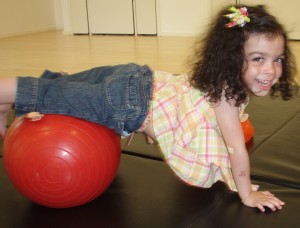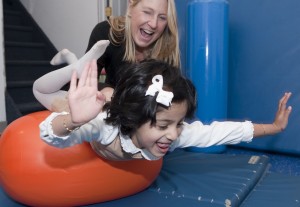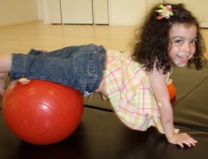 Big, colorful exercise balls are a staple of gyms and therapeutic settings. Because of the dynamic nature of balls (they roll), more core work is required to stay on the ball. The muscles necessary for balancing get into the act. That’s why trainers and therapist have used them for years. Children like them because they are fun.
Big, colorful exercise balls are a staple of gyms and therapeutic settings. Because of the dynamic nature of balls (they roll), more core work is required to stay on the ball. The muscles necessary for balancing get into the act. That’s why trainers and therapist have used them for years. Children like them because they are fun.
Equipment:
- Inflatable ball
- Very small children can use and oversized beach ball
- Regular sized kids (3-5) can usually use an inexpensive large plastic ball found in grocery stores and big box stores
- Gym balls:
- Size: The child should be able to sit on top and feet just touch the floor. If bigger than this, an adult needs to be sure to provide added support.
Benefits:
- Because the ball moves, muscles all over the trunk work to maintain balance.
- By looking forward, back and neck muscles get stronger.
- As the hands support weight of the body on the floor, the arms, wrists, hands and fingers get stronger.
- This is a HEAVY WORK activity. As the child works hard, proprioceptors are firing and helping to get filters working in the brain for good attention and focus.
Directions:
Blast off: The child holds arms up as I count “10, 9, 8…Blast off!” The child is thrust forward and lands on open hands on the floor (a carpeted surface is recommended).
Statue or Freeze: The child moves forward on hands until you say “freeze” and the child is suppose to stop and stay still like a statue.
Red Light Green Light: Slightly more dynamic but essentially the same as above. The child stops and goes in various locations. this not only strengthens the back but also challenges balance reactions.
Special Considerations:
- When children have weak core strength (e.g. the back sags) provide extra support in the hips as the child walks out on hands.
- Encourage the child to keep hands open for extra strengthening of hand muscles.
- Children with Sensory Processing issues love doing these activities repeatedly!

